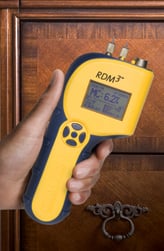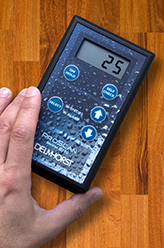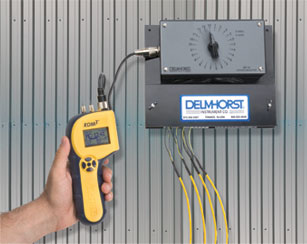 Mills and dry kilns deal with lumber every day, taking raw lumber and processing it into useable material for flooring, furniture, and dozens of other uses. For these industrial facilities, controlling moisture in lumber is a critical task, one that directly influences the quality of the finished product.
Mills and dry kilns deal with lumber every day, taking raw lumber and processing it into useable material for flooring, furniture, and dozens of other uses. For these industrial facilities, controlling moisture in lumber is a critical task, one that directly influences the quality of the finished product.
For example, when shipping wood to furniture makers, excess moisture can cause the wood to warp as it dries out in transit. By acclimating wood before shipping it, mills can reduce the risk of severe warping.
But, how can a mill be sure that their wood is free of excess moisture? One way to be sure is to use lumber moisture meters to test the moisture content of wood.
There are many different kinds of moisture meters for lumber, from pin-type handheld units, to pinless meters, to remote monitoring units designed to test moisture while lumber is still in the kiln.
Here are a few details about each of the different kinds of Delmhorst moisture meters for use by the industrial lumber mill industry:
1: The RDM-3
One of Delmhorst’s most advanced pin-type meters, the RDM-3 is designed to provide superior statistical information to the user. The bright, clear digital display has the ability to display not only the most recent moisture measurement you’ve taken, but stored readings as well so you have a comparison point for each measurement you take.
The RDM-3 has one of the most comprehensive species correction capabilities of any Delmhorst meter, with built-in corrections for 69 different species of wood. Additionally, the meter can make adjustments for temperature for when you’re testing wood in the kiln. With an operating temperature range of -4° to 158°F (-20 to 70°C), the RDM-3 can go with you into both hot and cold environments.
A universal probe adaptor at the top of the meter allows you to pair the RDM-3 with any of Delmhorst’s specialized moisture probe attachments to fit your monitoring needs. This can help when you need to take deep moisture readings near the core of a thicker piece of lumber.
For example, using Delmhorst's hammer-type insulated probes can allow you to take independent shell and core moisture readings, which allows you to evaluate the moisture gradient throughout a length of lumber. This is important to a proper drying process, as it allows you to get an indication of the uniformity of moisture distribution throughout the wood.
For many lumber mills, the RDM-3 is an indispensable tool for monitoring lumber moisture.
2: The ProScan

Delmhorst’s ProScan meter is a pinless moisture meter that excels at checking moisture in process lumber in the mill or the kiln. Because the meter is noninvasive, it can take readings in lumber without leaving the telltale pinholes that pin-type meters would.
If your mill works with a variety of lumber types, the ProScan’s built-in species correction can help you save time and labor while maximizing the accuracy of your moisture readings. Normally, to adjust for the differences in specific gravity between wood species, you’d have to consult a chart, or use a formula to get a more accurate measurement. By doing the correction for you, the meter makes this task instantaneous and easy.
Finally, this meter helps ensure continued accuracy with built-in battery and calibration checks that you can use to verify accuracy on a moment’s notice.
3: The KIL-MO-TROL System
 While not a moisture meter per-se, the KIL-MO-TROL system from Delmhorst can help you monitor the current moisture content of your lumber during the drying process. The big advantage of using this system is that it lets you take moisture readings without having to enter the kiln using a series of stations that you set before the kiln drying process begins. This speeds along the drying process and makes it safer to take readings in a hot kiln.
While not a moisture meter per-se, the KIL-MO-TROL system from Delmhorst can help you monitor the current moisture content of your lumber during the drying process. The big advantage of using this system is that it lets you take moisture readings without having to enter the kiln using a series of stations that you set before the kiln drying process begins. This speeds along the drying process and makes it safer to take readings in a hot kiln.
This system uses Chemours’ Teflon® coating to insulate cable sheaths, ensuring that the cables connecting the moisture-monitoring pins to the KIL-MO-TROL are able to withstand the environment of your kiln. Each cable has banana plugs to make connecting and disconnecting them quick and easy.
The pins themselves are also insulated except for at the tips so you can get separate shell and core moisture readings for each station being monitored. By monitoring the difference between shell and core moisture, you can make more informed decision about how to handle kiln drying operations.
Once set up, just connect a Delmhorst moisture meter, such as the RDM-3, to the KIL-MO-TROL and start taking readings. When you want to check a different station, simply turn the dial to the desired number.
These are just a few of the handy moisture measuring devices that Delmhorst has to offer for lumber mills and dry kilns. With the right moisture monitoring tools, controlling lumber moisture can be easy.

Comments